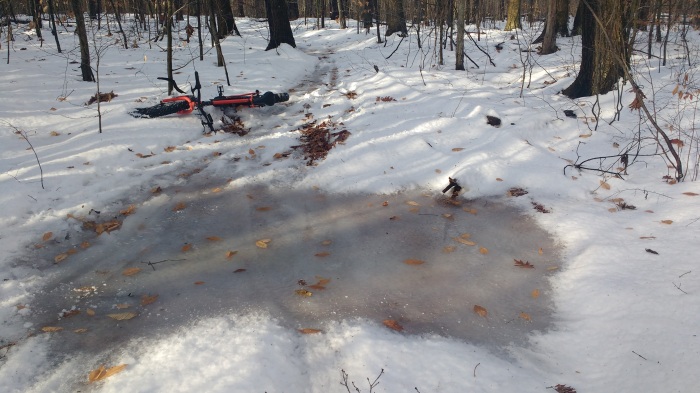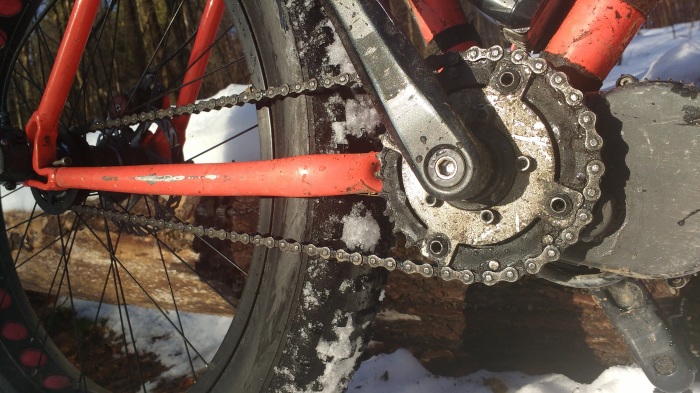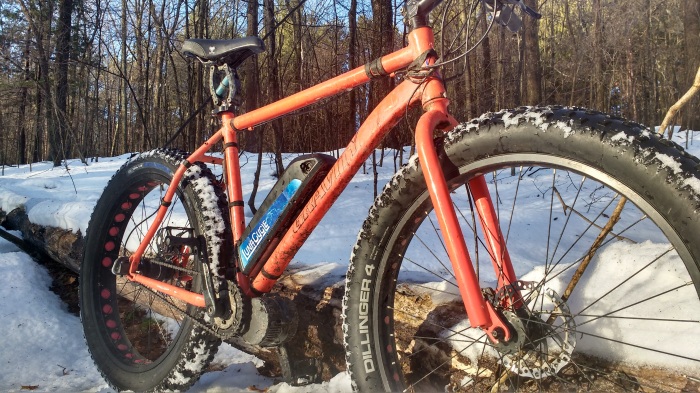Two years ago I wrote this post about riding Electric Fatbikes in the snow which had a lot of great tips. For the past 2 years I’ve been riding almost every day in the winter on my efatbikes and I’ve learned a few more things in the last 2 years. I’m going to try to add to my last article without being too repetitive.
1) Top off your battery before you go out : I charge everything to 100% and if it’s been sitting on the charger for more than 24 hours I unplug it, wait a minute and plug the charger back in, to top the battery off. Deep powder has an insatiable appetite for watts and whatever power I take out to the woods I inevitably burn through. If the trails have no new snow and are packed down then I can get by riding for over an hour with a 52v 13.5 Wh frame pack, if there is snow to plow through I take my 52v 25Ah 50Amp Cont GA home-built framepack. If I keep the batteries in a backpack I seem to get more power out of them possibly because the backpack keeps them warmer.
2) Keep your ebike & battery nice and warm before you go out : I have 3 boot trays laid down next to each other and every time I’m done riding I roll my fatbike in to melt off inside my house. When I used to keep my efatbikes outside after riding I had every manner of problem you could imagine frozen bearings, derailleurs, brakes and chains. With the bike stored inside it’s good to go when I am. Lithium batteries can lose up to half of their capacity when they are really cold. I go out even when it’s negative 20 or so out which would be pretty bad for the battery if it weren’t closed up in my backpack.
3) Point the front wheel where you want to go but don’t expect to get there : Depending on the snow conditions your front tire might go where you want or it might go somewhere else. Keep your body loose and prepare to compensate and constantly redirect the bike. If your body position is straight up and down and you turn the front wheel violently it will tend to slide straight. If you’re trapped in a deep frozen rut and try to steer out of it the bike will most likely just follow the rut.

Wipeout on a large ice patch. If you only have a front studded tire it won’t help you that much on the big patches.
4) Think of the whole riding experience as controlled skidding : Most of the time my back wheel is spinning out because I’m hitting the throttle or sliding out because I’m locking up the brakes. After a while, you learn to predict where the back wheel will go (it will always slide downhill and opposite the direction the bike is leaned over in) and do appropriate leans and slides to get the bike pointed where you want it to. I never ever use the front brake and only the back. If I want to slow down and the rear brake is not working because it is wet from all the snow and Ice just head for the fresh powder and the bike will slow down pretty fast on it’s own. If you squeeze the front brake hard then you are almost guaranteed a wipeout.
5) Speed is your friend : Sounds counterintuitive but it works. The rotational stability from the wheels adds dramatically to the stability of the bike as a whole. The faster you go the more the fatty will ride up on the snow and the easier it will be to get it to go where you want it to. When there are no trees I open up the throttle and slide all over the place, when the trees are tight I take it easy and try to keep everything together. It helps to forget about pedaling and just put all your weight on one foot and use your inside foot as stability to slide around corners with like motocross guys do. Don’t look at the trees, look at the open spaces that you want to go. This is particularly important when you lose control.
6) Park your car at the lowest point : When stuff breaks (it will) or your battery dies it’s much easier to limp home when your car is at a lower elevation than you. Start low and burn up your battery getting up the hills than coast back down. If you don’t have enough power then follow the groomed snowmobile trails or roads up then cut through the powder on the downhill. Going downhill in deep powder takes MUCH less power than going uphill in deep powder.

The BBS02 with a 32T ring and a Nexus-3 is insanely reliable. No problems at all with this setup and hundreds of miles ridden hard with it
7) When in doubt just go out : In 3 years there have only been a handful of times that have actually sucked. Eskimos have 50 words for snow and you’ll quickly learn that there is a variety of different conditions to ride in. 90% of the time when I think the trails are going to suck they are actually awesome. If the trails suck in the morning, they might be great in the afternoon when the snow softens up a bit. Today was 45 degrees and it rained all day so I didn’t feel like going out, but I did and it was really awesome as there was still plenty of snow and I had decent traction in the slush puppies.
8) Have more than one ebike : I have about 15 eFatties of which usually at least 3 of them are functional at any one time. Be prepared for stuff to break and be out of commission for a week or two. This winter I have Sunkiss which is a BBS02 Nexus-3 (32T front\18T rear) with a Dillinger 4 studded 4 inch tire on the front for ice and packed slush, but most of the time I prefer the Ludicrous 50 Amp BBSHD Phat Phuk which has the massive Snowshoe 2XL 5.05″ actual width tires. In powder or deep snow you’ll need the biggest rear fat tire you can fit in the frame without rub-a-dub-dubbing.

When the trails are packed down I opt for the BBS02 but when the snow is thick and heavy it’s 50Amp BBSHD all the way, baby
9) No matter how much power you have, it won’t be enough : Power is addicting and when you are pushing the limits of the motor/batteries in deep, wet snow you quickly learn that when you need it you’ll use every watt you can squeeze out of your system. In foot-deep snow when you slow down and stop your back wheel will quickly sink down to the earth. You will have to lift your weight off the seat and slowly spin the tire to get it to climb back out again of the snow so you can get going again.
10) Want less wheelies? Keep your weight on the pedals not the seat : High power ebikes want to wheelie all the time whenever you tap the throttle. When you keep the weight on one of the pedals the bike will tend to be more controllable and less like a bucking bronco.
11) Lube the chain before every ride : I buy Pedro’s Go! lube in a giant 1 liter bottle from bikeman.com for $9.89 (retail $45) right here which is about a 2 year supply. It’s easy to refill the little 4oz bottles by pouring the lube into a shallow container and using the squeeze bottle like a suction system to refill it by slurping it up. I stash 4 oz bottles in every car I have (I have 6, and they all suck) so that bike lube is never more than an arms length away.

My $300 Subaru winter rat (ebike is worth 4x that), notice the vice grips on the passenger side gas strut. Classy.
12) Transport your bike inside your car : Road salt will destroy your rotors and chain if you use an external bike rack in the winter. If you take the front wheel off and put the back seats down you can generally fit the fatty into most normal car trunks. Get a $300 winter rat so your nice car doesn’t rust out and use some rubber floor mats to collect the snow and slush.
13) Tire pressure is everything : If you’re not having a good time in the snow it’s probably because your tire pressure is too high. When in doubt let it out. You should not be running over 10psi and I find the optimal pressure to be between 5-8psi. The front tire can use lower pressure because there is very little weight on it most of the time, the rear tire should have enough pressure to not get pinch flats. Analog gauges are inaccurate at low PSI, Digital gauges are the way to go. I bought a slime digital gauge from Ollies for $2 and use it all the time. Lower tire pressure also means you will use more watts to get up to speed. With a tube on the rear you’ll want to go no lower than 8psi or you’ll risk shredding off the valve stem with 2500W. Ghetto tubeless is the way to go if you want to use less than 8psi, but make sure to use sub-zero sealant. I prefer Orange Seal to Stan’s and I buy it in the large 16oz bottles on ebay. You will need to add a few oz of sealant every year as it dries up and sticks to the inside of the tire over time.
14) Fancy pedals are just no good : Expensive aluminum or plastic pedals tend to ice up and your feet will slide right off when you least expect it. Go with the cheap, heavy metal bear claws, they are worth the chewed up shins. Forget about the clips, you’ll need to use your feet to catch the bike from sliding out from under you at almost every turn.

When the trails get melted down and there are ice patches the 750W BBS02 ebike is my weapon of choice, front studs are mandatory on ice unless you like to wipe out on every icy puddle
15) Ignore the haters : No matter what people say to you, you need to learn to let it slide. People seem to be either in a state of projection or denial and if you feel like what you’re doing isn’t hurting anyone then don’t let other people’s opinions deter you. I used to ski in the woods at for whatever reason every ski resort in NY will mercilessly harass you for it. I spent 10 years getting yelled at by ski patrol at my home mountain, Greek Peak. I would just hide headphones inside my helmet and wear full body armor and ski like an absolute maniac. When I wiped out on the moguls it would generally become an aerial frontflip and always brought cheers from the chairlift riders. After getting busted coming out of the woods (one day I got harassed 4 different times) the ski patrol would stand there yelling at me while I just waited and said things like ‘yes sir’ every time there was a pause and kept nodding my head like I understood what he was saying. The reality is that while he was talking I had crazy deathmetal music blaring in my ears and I never really heard a single word they were saying. Long story short, I never hit a tree and never hit anyone else, even though I ski backwards faster than most people ski forwards. I accepted responsibility for my skiing in the woods and would not have sued anyone if I got hurt. The hardest thing is when your close mountain biking friends start giving you crap for riding ebikes on the trails. The best remedy for that is to put an ebike in their hands and let them try it out. This allows them to see that efatbiking is not whatever they think it is and is actually really fun and doesn’t shred the trails. Every single skeptic that I’ve let ride one of my ebikes has become a believer. Love conquers hate (almost) every time.
I’ve got to say that electric fat biking in the woods is one of the most exciting things I’ve ever done, and I’ve done a lot of exciting things. It’s gotten to the point where I feel so addicted to it that if I can’t do it every day then I just don’t think I want to be alive anymore. The other day I drove over two hours just to ride in the woods because I hadn’t ridden in 2 days.
Efatbiking takes time to learn, and it takes a hell of a lot of practice to get good, but once you get it, there really is nothing quite like it.
Ride On.

No comments:
Post a Comment